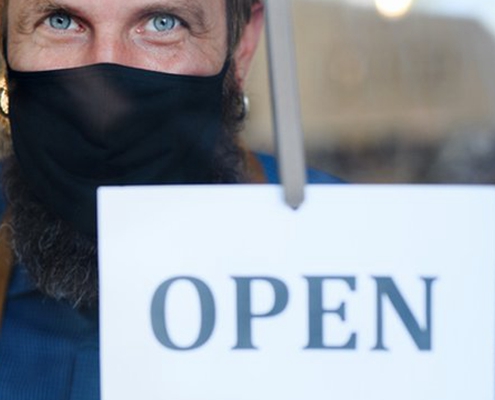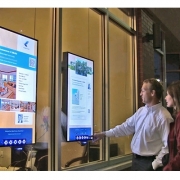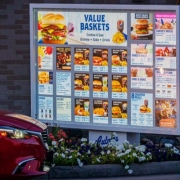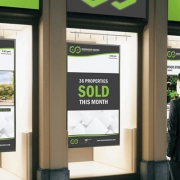How digital signage can help you reopen safely
Municipalities and organizations around the country are beginning to relax COVID-19 restrictions, but things can get confusing pretty fast for people. Each state, county and city may have their own guidelines, and even individual organizations or different facilities can have their own set of rules. By leveraging the power of digital signage, you can make sure that everyone who goes to your location, whether it’s customers, visitors, employees or students, knows what to do and where to go. And, more importantly, how to stay safe and healthy.
Obviously, you’ll want some sort of welcome back message up on the digital signs. This is more than just a “feel good” tactic; it also serves to remind your audience that things are a little different now and that there may be changes that they need to pay attention to. Also, this is a great opportunity to thank your staff and clients for supporting you during the closure.
Some places are requiring visitors to either pre-register or register upon entering a building. If this is the case, a reminder message on entryway or reception screens will help set expectations, and you can provide instructions for how to register or contact the person you’ve come to see right on screen.

Buildings may also have a maximum capacity for the time being. Tying a data source like Excel to your digital signs will help people keep track of how many people are currently onsite. And it updates automatically on screen as numbers are entered in the spreadsheet. Elevators and other enclosed spaces may also have capacity limits. You might post physical signs at strategic locations, but the digital messages can help reinforce these rules, as well as make you iconography and imagery familiar to the audience. If there are areas that are off limits to visitors, a message with that information, and maybe a map of restricted locations, would also help head off potential problems.
It will be important to include messages about your facility’s policy on masks and social distancing (for walking, standing, queuing and even sitting). You’re almost certainly going to want to include frequent reminders to wash hands. You may also have disinfectant or bottles of hand sanitizer in various locations, and messages on the digital signs can not only remind people when they should use this (for example, before touching elevator buttons), but where those hygiene stations are in the facility.
To minimize how often people need to touch things, you might add a policy of trying to leave doors open whenever possible, or to take the stairs over the elevator if your destination is just a couple of floors away.
Some organizations are implementing one-way hallways to help people maintain proper distancing. High Brightness LCD Digital Signs can point the way with simple directional arrows. Some stairways may also become one-way during this transition period, with certain ones being “up only” while other are “down only.” Even if you have these instructions on screens, it’s still a good idea to put directional markers on floors and stairway doors.
Reminders to wipe down workstations and other areas used when finished are also a good idea. It may seem obvious, but there’s a lot of newness going on, and reminding people can only be of benefit to them and your organization. Similarly, messages telling people to cover their mouth when coughing or sneezing, and to stay home if they feel any symptoms may seem like overkill, but it’s better to be safe than sorry. Even policies like not sharing pens, cups and other commonplace items are a good idea.
On-site locations such as café or gyms may remain closed or have new hours of operation, or they may have rules of their own. Again, use your digital signs to keep people updated so you can set accurate expectations and avoid confusion or frustration.
If you have interactive lcd displays, QR codes are a great way to retain the benefits of interactivity without asking people to touch screens. Adding a voice-use interface, where people interact with the lcd screen simply by talking to it, keeps all of your interactive option while minimizing risk to your audience. At the very least, you should have sanitizer next to the lcd screens, and reminder messages to wipe it down after use to minimize germ transmission.
You can also add a voice interface to some interactive meeting room digital signs, making them a totally hands-free option for space management. If you can’t do that, you can still put messages on your room digital signs that list things like current seating capacity, and maybe show a seating chart with spacing recommendations. Policies about how to enter and exit meeting rooms (for example, always enter/exit in a clockwise direction) can help avoid crowding around doorways. Room signs can also show if a room is waiting to be cleaned, in the process of being cleaned, or is ready to go for the next group of people.
Even if you don’t have room digital signs, you can still put room capacities, seating recommendations and other room policies on your large screens. This can help your staff to know which rooms are best for their meeting, and what to expect when they get there. And this isn’t just for meetings, you can do the same for computer labs, cafeterias, libraries, huddle/collab places, lounges and any other shared spaces.
On all of your reopening messages, try to include a QR tag or short URL that lets people access a comprehensive list of current guidelines on your intranet or website. Including links to state or county guidelines, or even CDC recommendations, can also be helpful to remind people that all of these new rules are part of a much larger picture.
And don’t forget to reinforce the positive. COVID-19 has created major change in people’s lives, and getting used to new rules can cause some people to feel anxious. So, try to counteract that with some inspirational, motivational or even funny messages. As restrictions are lifted, instead of simply discontinuing those messages, celebrate that change and let people know about the most recent step toward normalcy. Lightening the mood helps everyone deal with the current situation better, and creates community and unity.
Hopefully, people were already used to relying on your lcd digital signs for current info, so getting on-screen updates about reopening measures should seem natural to them as they come back to your office, school or shop. The key is transparency and communication, and with the right reopening messages you can ease stress, minimize disruptions, and keep everyone safe and healthy.












